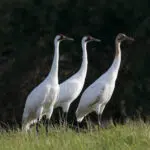The Whooping Crane Festival is celebrated over four days from February 24 to 27 each year. Let’s start with the basics by introducing you to the whooping crane. You’ll know you’ve seen one if you see a large white crane with black wingtips, legs, and feet, some black markings on its face, and a red bald spot right on top of the head. Of course, the most distinctive feature is the whooping call it makes, which gives it its name. Unfortunately, you will only see these birds in the Coastal Bend region of Texas since this is the only region left in the U.S. where these cranes naturally occur.
History of Whooping Crane Festival
The Whooping Crane Festival was first instituted in 1996, by the Port Aransas Chamber of Commerce, in order to honor these very special birds. One of the rarest species of cranes, the whooping crane is historically one of the oldest species of living birds today and happens to be endangered. Since the Coastal Bend is the only area of the U.S. where these birds can be observed in their natural habitat, it makes sense that there be a big hoo-ha about it. This is the time when the whooping cranes fly back from Canada to the marshy warmth of the Aransas National Wildlife Refuge, which is their spot for the winter season.
The whooping cranes are just one among a number of other migratory birds which prefer this region to winter in, therefore the key highlights of the festivities include bird-watching tours, a trade show to feature vendors, photography expeditions, and specialist speaker panels; to name but a few. The purpose for the festival being established is clear — the Port Aransas Chamber of Commerce partnered with the International Crane Foundation (I.C.F.) to raise awareness of, and funds towards, the conservation efforts being made to save the cranes from extinction. Therefore, all proceeds from the festival go to the I.C.F. to aid this mission.
Coming to the history of the cranes, the oldest crane fossil was found in Nebraska and is said to be around 10 million years old. Before the Europeans began to settle in North America in the 1800s, the whooping crane population was quite large. As the settlers began to drain the wetlands for agricultural use, the population declined due to the destruction of their natural habitat. By the 1940s, the number dipped to below 50, and it was not until 1954 that wild whooping cranes were spotted again; thanks to a wildfire in Canada’s Wood Buffalo National Park. This led to captive breeding of the cranes in order to restore their numbers, and thanks to years of effort, there are over 800 whooping cranes in existence now (though still endangered).
Whooping Crane Festival timeline
Whooping cranes are hunted for meat and feathers, and their homes are destroyed.
It becomes illegal to hunt, capture, sell, or kill any migratory bird species without a permit.
The population of the birds drops to an alarming 15.
The population of whooping cranes soars to 214, thanks to stakeholder collaborations.
Whooping Crane Festival FAQs
Are the whooping cranes still in Texas?
Yes, they are, which is why the Whooping Crane Festival is celebrated year on year, in honor of these incredible birds, and as an important means of funding their survival.
Why is the whooping crane important?
Well, just consider the food chain. As per the laws of nature, the whooping crane’s part in the ecosystem at large is to eat different plants and animals. In turn, the whooping crane is a delectable treat for all sorts of predators like wolves, foxes, coyotes, raccoons, and lynxes. They help keep the system in check, balancing the natural order of things that we humans all too
often mess with.
What happened to the whooping crane?
Unfortunately, the whooping crane is now an endangered species for several reasons. Huge swathes of their natural habitat have been destroyed, and these birds were hunted for their meat and plumage.
Whooping Crane Festival Activities
Join in the festival
Nothing like getting up close and personal with the whooping cranes themselves! Book yourself a trip to Port Aransas and immerse yourself in this four-day long event which features a whole lot of activities ranging from special guided tours, boat tours, a trade show, specialist speaker panels, and a whole load more.
Support the conservation effort
Apart from partnering with or donating to leading conservation organizations, like the International Crane Foundation, support can also be shown by publicizing the efforts which have been made by conservationists. Read up on the International Whooping Crane Recovery Team and the amazing leaps they took to save the species — we guarantee you will want to share those stories.
Create awareness
There are tons of ways to create buzz around the issue of wildlife conservation, especially of an endangered species like the whooping crane. With social media at your fingertips, get your creative juices flowing by maybe holding a crane-themed event in your locality (did someone say dance party?).
5 Crane Facts To Blow Your Cranium
Nature’s monogamists
Cranes tend to bond with their partners for life, staying faithful and true.
Continent-specific
Cranes are found on all continents except South America and Antarctica.
Himalayan cruisers
The Eurasian cranes can fly at altitudes of up to 32,800 feet above the Himalayan peaks.
Boogie birds
Whooping cranes, despite age and species, love to dance.
Ancient history
Cranes are historically one of the oldest species of birds, according to fossil evidence.
Why We Love Whooping Crane Festival
Cranes are cultural
The great thing about this festival is that it gets us thinking about cranes. Not only can we use the opportunity to learn more about these fascinating birds, but they also are laden with cultural connotations for different people groups all over the world. For instance, did you know that the Ugandan flag features a crane on it? We urge you to find out more.
It gives pause for a cause
Many may not know much about the efforts which go into the conservation of endangered species so festivals like these are a great way to shake things up. They get people talking about the need to share the planet with others who have been around for way longer than us.
It celebrates wildlife
When was the last time you took time out to go and commune with nature? Be it a hike, camping, fishing, bird-watching, or visiting a wildlife reserve; there are so many opportunities to experience wildlife and keep that sense of wonder. It’s even more special when a species can be saved for future generations to also marvel at and feel the same things we do.
Whooping Crane Festival dates
| Year | Date | Day |
|---|---|---|
| 2026 | February 24 | Tuesday |
| 2027 | February 24 | Wednesday |
| 2028 | February 24 | Thursday |
| 2029 | February 24 | Saturday |
| 2030 | February 24 | Sunday |













